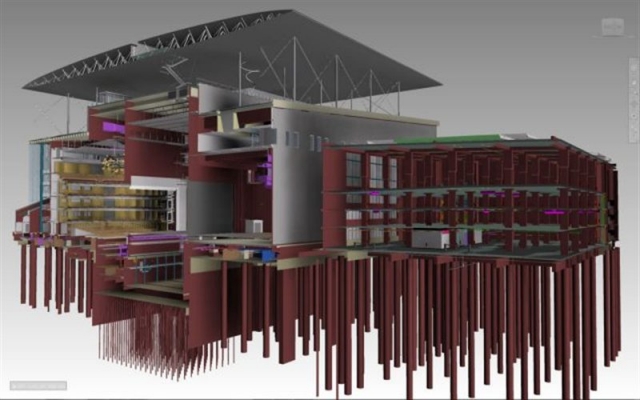The construction works of the Cultural Centre in Faliro
The construction works of the Cultural Centre of Stavros Niarchos Foundation in the Athens neighbourhood of Faliro designed by famous Italian architect Renzo Piano are progressing on schedule under the guidance of holding ΤΕRΝΑ-Impregilo.
The project, which is expected to be completed and submitted to the Greek state in 2015, "celebrated" the meeting of the deadline of the first stage, involving the completion of the excavation works and the construction of the foundations of all the buildings. The project with a budget of 566 million euro, financed entirely by the Stavros Niarchos Foundation already employs about 700 people and it is expected that this number will double in the subsequent construction.
The cultural centre will consist of a park of total area 170,000 square metres and will accommodate the buildings of the National Library of Greece and the National Opera. It will also consist of a covered parking lot for 1,000 cars, a water channel and 3 auxiliary buildings, as announced by the holding.

A 3D image of the future building of the National Opera
An artificial hill, a water channel and a wide avenue, "Esplanade" will be built in the area around the park where 1,500 trees (aged between 10 and 80 years), which have already been selected and adapted to the local climate of Attica, and 350,000 shrubs will be planted.
The new buildings of the National Library and the National Opera (suitable for 1,400 spectators) will be connected and a large open space, the Agora, will form between them.

The Agora
The highest part of the artificial hill will reach 14 metres and it will cover the roofs of the National Library and the parking lot.
After the completion of the project, the holding will be able to maintain the site for 5 years but the state will have the right of choice, as the Stavros Niarchos Foundation will transfer to it the only share of the contractor, Stavros Niarchos Foundation - Cultural Centre.
Innovative and ecological
The construction works are completely following innovative and environmentally friendly practices. For example, all heavy-freight lorries are being washed before leaving the construction site and do not pollute the environment.
The balance of the soil during the excavation work is zero, as materials from the old racecourse are used in the works and no soil is being transported to the construction site or out of it, as stated by project manager Michalis Papafilipou. The same applies to the hydrologic balance as the drills of the park are used.

Water channel
Other "green" methods such as the use of natural materials for the construction of the artificial hill and for the wide mounds of gravel and soil are being applied as well.
Archaeological activities
Project Archaeologist Michalis Ginalas states that GEK-ΤΕRΝΑ is perhaps the only group that appoints an archaeologist due to which the large-scale-excavations of the remains of people who had been convicted, tortured and subsequently executed, which started in the region in the early 20th century, are continuing.
The excavations were carried out during the preliminary activities and unearthed 700 such graves out of 1,500, which have enriched the archaeological evidence as to how the inhabitants of ancient Athens had lived and died, as the cemetery of Flisvos was located in the area in question.
The archaeological activities employ 70 people whose support is entirely undertaken by the Stavros Niarchos Foundation. Furthermore, one of the auxiliary buildings will house a museum.
Moving buildings and other innovations
The construction works also involve modern seismic solutions such as special insulation that allows the horizontal movement of buildings of up to 35 cm which so far have been applied only to the new Acropolis Museum and the theatre and music centre of the Onassis Foundation. The seismic protection of the building is much better than stipulated in the anti-seismic regulations, as stated by Papafilipou.
At the same time, the team had to deal with natural hindrances such as the poor quality of the subsoil which had led to the need for deeper foundations, reaching up to 18 metres in depth. Furthermore, 1,000 columns of 1.2 metres in diameter have been placed, and the method of "reinforced earth", which is applied for the first time in the world for this kind of construction, (it is typically used in highway construction), has been used for the seismic protection of the hill. Papafilipou states that it uses geogrids with a long period of aging, over 100 years, stressing that, in this way, no concrete will be used for the hill. The geogrids allow water circulation and prevent landslides.
Impressive roof
The roof that will be built on the National Opera is innovative too. It will consist of solar panels that will meet the energy needs of the park. Special materials such as ferrocement, which has been subject to tenacity tests, will allow them to move depending on wind direction.

The roof of the National Opera
In addition, a footbridge connecting Sygrou Avenue with Esplanade Avenue has been constructed and the highest number of cranes in Greece at present, namely 11, is currently operating on the site.